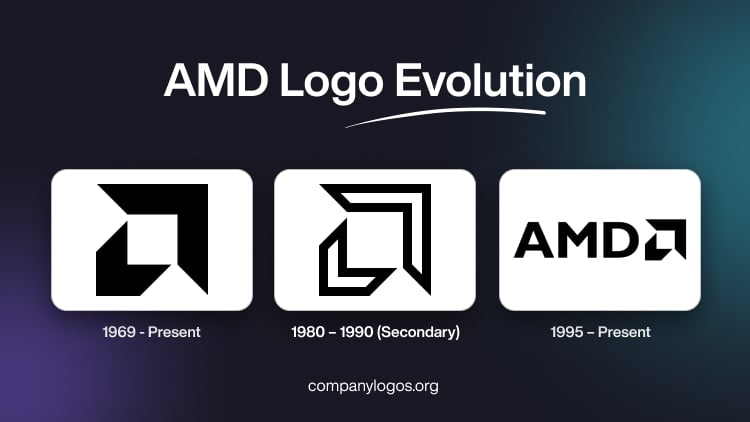
AMD, or Advanced Micro Devices, is a US-based manufacturer of computer processors. Established in 1969, the company’s products are designed for servers, desktop computers, laptops, and gaming consoles. Its main rivals are NVIDIA and Intel, and the company, besides being a titan in the semiconductor industry, has maintained a consistent and symbolically rich brand identity.
The AMD logo is known for its iconic arrow motif, which has evolved subtly over the decades. The logo reflects the unwavering commitment of the company to progress and innovation while simultaneously preserving its heritage. The article delves into the evolution of the AMD logo, among other details.
The Genesis of the AMD Logo (1969 – Present)
The original logo was designed by Larry Bender, and it featured large and small arrowheads placed in opposite directions. These arrowheads could be interpreted as two right angles facing opposite directions but together forming what resembled a lowercase “a.” This nuanced design stood out visually and represented the pioneering spirit of AMD.
Designed in black, suggesting power and authority, the logo symbolised movement, momentum, and technological progress. Also, the arrows created a white square at the centre to symbolise an integrated circuit or chip, thereby establishing the focus of the company.

(1980 – 1990) (Secondary)
During the 1980s, AMD introduced a slightly revised version of its original emblem. Here, the core arrow motif remained, but with slight modifications. For instance, the arrows became white with a bold black outline, thereby providing a lighter and more modern appearance. The black lines around the arrows became more prominent, and the arrows themselves became a bit bolder.

(1995 – Present)
In the mid-1990s, AMD began integrating a wordmark into the logo. As a result, it paired the iconic arrow emblem with the “AMD” initials in a bold, sans-serif typeface in uppercase. The chosen font echoed boldness and geometric simplicity, which aligned with technological strength. The latest design is both modern and minimalistic, and it evokes a sense of power, confidence, and expertise.

The Elements of the AMD Logo
Font
The stable wordmark of the AMD logo is rendered in a modern geometric sans-serif typeface with distinctive contours of the letters. The font is similar to Gill Sans Bold or Humanist 521 Bold.
Colour
The colour palette of the AMD logo comprises black and dark green. The deep colour shades evoke a sense of loyalty and trustworthiness and reflect the values of professionalism and stability.
The History of AMD
AMD, or Advanced Micro Devices, was founded on May 1, 1969, by Jerry Sanders along with seven colleagues from Fairchild Semiconductor. The other founders were Edwin Turney, Jack Gifford, John Carey, Sven Simonsen, Frank Botte, Ray Davis, and Jim Giles. From its inception, AMD positioned itself as a challenger in the semiconductor industry and specialised in logic chips and memory components.
The first product of the company, the Am9300 shift register, was released in 1970, which was followed by the Am2501 logic counter in 1971. These helped establish AMD’s reputation for engineering excellence. In 1975, AMD entered the RAM market with the Am2900 series, which was a family of integrated circuits that became widely used in minicomputer designs.
In the 1980s, AMD made a strategic move into the microprocessor business by setting the stage for a decades-long rivalry with Intel. In 1982, AMD signed a technology licensing agreement with Intel. In doing so, it became a second-source supplier of x86 processors, which were essential for IBM’s personal computers. However, disputes quickly emerged as Intel attempted to limit AMD’s role, which resulted in a series of lengthy legal battles.
Despite the friction, AMD made significant strides in processor development. In 1991, it launched the Am386, a reverse-engineered microprocessor fully compatible with Intel’s 386 chip. This milestone showcased AMD’s technical capabilities and growing independence. The company continued producing x86-compatible processors such as the Am486 and Am5x86 through the early ’90s. In 1994, AMD achieved a major legal victory when the U.S. Supreme Court ruled in its favour with respect to its right to produce Intel-compatible chips. This affirmed AMD’s place as a legitimate competitor in the CPU market.
The late 1990s and early 2000s marked a golden era of technical breakthroughs for AMD. In 2000, AMD released the Athlon processor, which became the first consumer CPU to break the 1 GHz barrier. It was inarguably a huge milestone in computing performance. In 2003, AMD launched its Opteron server processors featuring the AMD64 architecture. These introduced 64-bit computing to the x86 world while retaining backward compatibility with 32-bit applications.
This innovation was quickly adopted across industries and set a new standard for performance and enterprise computing. AMD continued to innovate by expanding into the graphics market through its 2006 acquisition of ATI Technologies. This move brought GPU technologies into AMD’s portfolio and enabled the company to develop comprehensive computing platforms for both gaming and professional workloads.
In 2008, AMD underwent a major restructuring by spinning off its manufacturing operations into an independent entity known as GlobalFoundries. This shift allowed AMD to focus solely on chip design while outsourcing production. Despite this strategic move, the late 2000s and early 2010s were financially challenging years. The company endured restructuring, significant layoffs, and multiple changes in leadership.
Nonetheless, AMD reorganised into two primary business segments: Computing & Graphics and Enterprise, Embedded, and Semi-Custom. In 2017, AMD made a remarkable comeback by launching its Ryzen CPUs and EPYC server processors, which were built on the new Zen microarchitecture. These chips performed exceptionally well and re-established AMD as a serious competitor to Intel in both consumer and data centre markets.
The company stayed ahead with innovations like chiplet architecture and 3D V-Cache. In 2022, AMD expanded further by acquiring Xilinx, a leader in adaptive computing and FPGAs (field-programmable gate arrays). This acquisition empowered AMD’s offerings in AI, high-performance computing, and telecommunications.
For more than five decades, AMD has played a key role in shaping the modern semiconductor landscape. The company is widely credited with bringing real competition to the CPU and GPU markets, pushing innovation and lowering costs for consumers. AMD’s contributions extend across personal computing, video game consoles, enterprise data centres, and AI applications. Its contributions in the field of chip design make it not only a survivor in the competitive tech industry but also a thriving, dynamic force committed to driving the future of computing.
Interesting Facts About AMD
- AMD was founded on May 1, 1969, by Jerry Sanders and a group of engineers from Fairchild Semiconductor. Its original focus was producing logic chips before moving into the microprocessor market.
- AMD is best known as a long-time rival of Intel, especially in the x86 CPU market. The competition between AMD and Intel has driven significant innovation in personal computing.
- AMD introduced the first 64-bit x86 processor, the AMD Opteron, in 2003, which was well ahead of Intel. This architecture, known as x86-64, became the industry standard.
- In 2006, AMD acquired ATI Technologies, a major GPU manufacturer, for $5.4 billion. This move allowed AMD to compete directly with NVIDIA in the graphics market and laid the foundation for integrated CPU-GPU solutions (APUs).
- In 2017, AMD launched its highly successful Ryzen line of processors, based on the Zen architecture. This revitalised its reputation and market share in both consumer and professional segments.
- AMD provides custom chips for major gaming consoles, including PlayStation 4 & 5, Xbox One, Series X & Series S. These consoles use AMD’s CPU and GPU technology.
- AMD was the first company to release 7 nm x86 processors, starting with the Ryzen 3000 series in 2019. This move set a new benchmark for performance and power efficiency.
- Dr. Lisa Su, who has been the CEO since 2014, is widely credited for AMD’s resurgence. Under her leadership, AMD’s stock price and market share have soared.
- AMD has a strong presence in the open-source community, especially in Linux GPU drivers. Its Radeon Open Compute (ROCm) platform supports GPU computing in open ecosystems.
- In 2022, AMD acquired Xilinx, a leader in FPGAs (Field Programmable Gate Arrays), for $49 billion. This expanded AMD’s reach into adaptive computing and embedded systems.
- AMD was a pioneer in using chiplet architecture, starting with its Ryzen and EPYC CPUs. This modular approach helps improve scalability, performance, and production efficiency.
- AMD’s EPYC processors are now a strong alternative to Intel Xeon in the data centre space. These offer high core counts and better performance-per-watt metrics.
Finally
Unlike many corporate logos that have undergone dramatic transformation, the AMD logo has remained reassuringly consistent yet adaptable. Each logo evolution, from the bold black arrow of 1969 to the minimalist monochrome symbol of today, has continued to represent AMD’s pioneering ethos, relentless drive for innovation, and position as a trusted leader in the tech world.